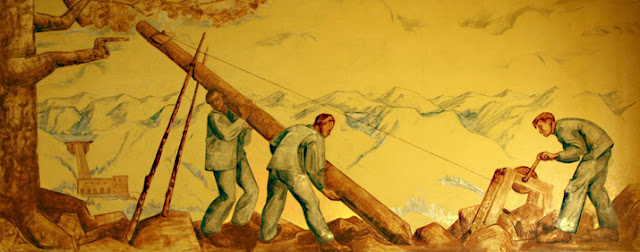Conference: Landscapes of Energy ı An exploration of physical landscapes of energy
The conference explores physical landscapes of energy such as mining, oil extraction and road construction, as well as immaterial energies in landscapes; i.e. those produced in and by lived landscaped practices such as fishing, birds in flight, mobile networks.
The contemporary landscape is seen as a field where human intervention, production, practices and imaginations intersect with ecological and material processes and presence.
Examples of contemporary landscapes are the exposed resource extraction landscapes of the north that are facing increased pressure in a geopolitical situation where energy policies lead to demographic shifts, infrastructural development and ecological adaptation. These landscapes are simultaneously produced both by industrial as well as local and indigenous social practices.
Documentation practices and mapping strategies are seminal to the exploration and conceptualization of new landscapes, and the conference brings together educators, researchers, writers, and practitioners in landscape architecture, architecture, archaeology and media arts involved in developing documentations practices in the contemporary landscape and its social, geological, ecological and infrastructural presence.
What: Landscapes of Energy ı An exploration of physical landscapes of energy
When: Oslo School of Architecture and Design, Thursday May 3 and Friday May 4, 10.00-14.00
Who:
Mason White: Latin American energy infrastructure
Lateral Office has been researching questions of culturally and environmentally sustainable development in Northern Canada and Greenland since 2009. The research examines questions of landscape, ecology, infrastructure, and architecture.
Luis Callejas: Latin American energy infrastructure
Luis Callejas, Landscape. Architecture, is an itinerant studio and international research platform. The practice establishes a reciprocal dialogue between landscape architecture and infrastructure through environmental operations.
James Kruse and Elizabeth Ellsworth:
SmudgeStudio is a media arts collaboration working on documentation of sites and moments where the geologic and the human converge, and responding to the natural, built, historic, strategic forces and the imagined.
Alessandra Ponte: The map and the territory
Alessandra Ponte is a full professor of architecture at the University in Montreal. She studies extreme landscapes, such as the Canadian Arctic, the Australian desert, the American West and the Atacama Desert in Chile.
John Palmesino and Ann-Sofi Rönnskog: North
Territorial Agency works to strengthen the capacity of local and international communities in comprehensive spatial transformation management; combining analysis, projects, advocacy and action and addressing changes in the relations between geography, inhabitation and knowledge production in the 21st century.
Janike Kampevold Larsen and Peter Hemmersam
Researchers at the Institute of Urbanism and Landscape at the Oslo School of Architecture and Design. Hemmersam is an architect and has done research on urban design, social media and sustainable urban development. Larsen is a literary scholar and is working with landscape theory and contemporary landscapes.
Rania Ghosn
Rania Ghosn's researches the territorial relationship between nature, technology, power, and her dissertation was a study of the history and politics of the Trans-Arabian Oil Pipeline. She is a founding editor of New Geographies, and is the editor of The Landscapes of Energy issue.
Sefryn Penrose: Images of Change
Sefryn Penrose is an archaeologist of the recent past (WS Atkins/Oxford University). She is the author of Images of Changes: an archaeology of England's contemporary landscape which maps the landscapes that define the later 20th-century world. She is currently working on the end of heavy industrial manufacturing in Britain and the transition to the service economy, and how archaeological methodologies can explore this landscape.
More: Here.



No comments:
Post a Comment